










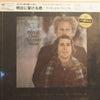
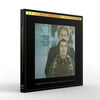

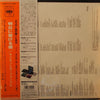
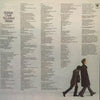
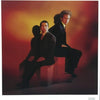
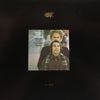
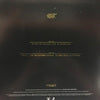
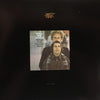
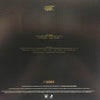
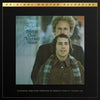
Simon and Garfunkel - Bridge Over Troubled Water (Edition Japonaise, 2LP, 45 tours, Coffret, 1STEP)
ORDER LIMITED TO ONE ITEM PER CUSTOMER
Simon & Garfunkel [click here to see more vinyl featuring Simon & Garfunkel]
Paul Simon – lead vocals, acoustic guitar, percussion [click here to see more products featuring Paul Simon]
Art Garfunkel – lead vocals, percussion [click here to see more products featuring Art Garfunkel]
Los Incas – Peruvian instruments
Joe Osborn – bass guitar
Larry Knechtel – piano
Fred Carter Jr. – guitar
Pete Drake – Dobro, pedal steel guitar
Hal Blaine – drums
Jimmie Haskell and Ernie Freeman – strings
Jon Faddis, Randy Brecker, Lew Soloff and Alan Rubin – Brass
Roy Halee – engineer and co-producer
Written by Paul Simon (all except A2 & D3), Felice and Boudleaux Bryant (D3). A2 is an arrangement of an 18th Century Peruvian Folk Melody by Jorge Milchberg.
2 LPs, box set
Limited edition
Original analog Master tape : YES
UD1S (UltraDisc One-Step)
Heavy Press : 180g
Record color : black
Speed : 45 RPM
Size : 12'’
Stereo
Studio & Live (D3)
Record Press : RTI
Label : MOFI
Original Label : Columbia
D3 recorded Live at Iowa State University, other tracks recorded at Columbia Studio B and E, New York City and CBS Columbia Square, Los Angeles in November 1968 and November 1969
Engineered & mixed by Roy Halee
Produced by Art Garfunkel, Paul Simon, Roy Halee
Remastered by Krieg Wunderlich
Originally released in 1970
Reissued in 2018
Tracks:
Side A:
- Bridge Over Troubled Water
- El Condor Pasa (If I Could)
Side B:
- Cecilia
- Keep The Customer Satisfied
- So Long, Frank Lloyd Wright
Side C:
- The Boxer
- Baby Driver
Side D:
- The Only Boy Living In New York
- You Don't Write Me
- Bye Bye Love
- Song For The Asking
Awards:
Rolling Stone 500 Greatest Albums of All Time - Rated 172/500!
1000 Recordings You Must Hear Before You Die - Ranked 197
TAS Super LP List! Special Merit: Informal
Stereophile Records to Die For - 2015
1971 Grammy Awards:
- Album of the Year
- Best Engineered Recording
- Record of the Year
- Song of the Year
- Contemporary Song of the Year
- Instrumental Arrangement of the Year
Reviews:
“Bridge Over Troubled Water was one of the biggest-selling albums of its decade, and it hasn't fallen too far down on the list in years since. Apart from the gospel-flavored title track, which took some evolution to get to what it finally became, however, much of Bridge Over Troubled Water also constitutes a stepping back from the music that Simon & Garfunkel had made on Bookends -- this was mostly because the creative partnership that had formed the body and the motivation for the duo's four prior albums literally consumed itself in the making of Bridge Over Troubled Water. The overall effect was perhaps the most delicately textured album to close out the 1960s from any major rock act. Bridge Over Troubled Water, at its most ambitious and bold, on its title track, was a quietly reassuring album; at other times, it was personal yet soothing; and at other times, it was just plain fun. The public in 1970 -- a very unsettled time politically, socially, and culturally -- embraced it; and whatever mood they captured, the songs matched the standard of craftsmanship that had been established on the duo's two prior albums. Between the record's overall quality and its four hits, the album held the number one position for two and a half months and spent years on the charts, racking up sales in excess of five million copies. The irony was that for all of the record's and the music's appeal, the duo's partnership ended in the course of creating and completing the album.” AllMusic Review by Bruce Eder
UltraDisc One-Step : Instead of utilizing the industry-standard three-step lacquer process, Mobile Fidelity Sound Lab's new UltraDisc One-Step (UD1S) uses only one step, bypassing two processes of generational loss. While three-step processing is designed for optimum yield and efficiency, UD1S is created for the ultimate in sound quality. Just as Mobile Fidelity pioneered the UHQR (Ultra High-Quality Record) with JVC in the 1980s, UD1S again represents another state-of-the-art advance in the record-manufacturing process. MFSL engineers begin with the original master tapes and meticulously cut a set of lacquers. These lacquers are used to create a very fragile, pristine UD1S stamper called a "convert." Delicate "converts" are then formed into the actual record stampers, producing a final product that literally and figuratively brings you closer to the music. By skipping the additional steps of pulling another positive and an additional negative, as done in the three-step process used in standard pressings, UD1S produces a final LP with the lowest noise floor possible today. The removal of the additional two steps of generational loss in the plating process reveals tremendous amounts of extra musical detail and dynamics, which are otherwise lost due to the standard copying process. The exclusive nature of these very limited pressings guarantees that every UD1S pressing serves as an immaculate replica of the lacquer sourced directly from the original master tape. Every conceivable aspect of vinyl production is optimized to produce the most perfect record album available today.
Ratings :
AllMusic : 5 / 5 , Discogs : 4,89 / 5

